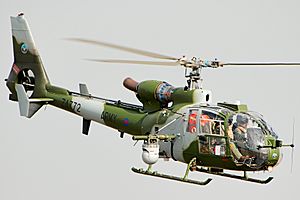1978 British Army Gazelle downing facts for kids
Quick facts for kids 1978 British Army Gazelle downing |
|||||||
|---|---|---|---|---|---|---|---|
| Part of the Troubles and Operation Banner | |||||||
 A British Army Gazelle helicopter |
|||||||
|
|||||||
| Belligerents | |||||||
• |
|||||||
| Commanders and leaders | |||||||
| unknown | † Lieutenant Colonel Ian Douglas Corden-Lloyd MC OBE |
||||||
| Strength | |||||||
| 1 active service unit | 1 Army section 2 helicopters |
||||||
| Casualties and losses | |||||||
| unknown | 1 killed 2 wounded 1 helicopter lost |
||||||
On February 17, 1978, a British Army helicopter called a Gazelle crashed in Northern Ireland. It was hit by gunfire from a group called the Provisional IRA. The IRA group was fighting with British soldiers on the ground. The helicopter was sent to help these soldiers. The pilot lost control while trying to avoid the shots, and the helicopter crashed. Lieutenant Colonel Ian Douglas Corden-Lloyd, a British Army commander, died in the crash. This event was not widely reported because another major incident, the La Mon restaurant bombing, happened just hours later.
What Led to the Crash?
By early 1978, the British Army in Northern Ireland was using new Gazelle helicopters. These new helicopters were better than their old ones. They could fly longer and cover more areas. At the same time, the Provisional IRA got new powerful machine guns. These guns were shown off during a public event.
Helicopters were very important for the British Army, especially near the border with the Republic of Ireland. In some areas, like south County Armagh, soldiers and supplies had to be moved by helicopter because of the high level of IRA activity.
The Royal Green Jackets, a British Army regiment, had been in South Armagh since December 1977. They had already faced some attacks. For example, their base was hit by bombs, and some soldiers were hurt. Another time, a patrol was attacked with a bomb and guns, and a sergeant was badly injured. He had to leave the army because of his injuries.
The Shooting and Crash
On January 17, 1978, a group of British soldiers were watching an area near the village of Jonesborough. They came under heavy gunfire from a place called the "March Wall," which was close to the Irish border. The soldiers shot back, but they couldn't move forward because of the open ground and how close they were to the border.
Lieutenant Colonel Ian Corden-Lloyd, the commander, flew to the scene with two other soldiers to see what was happening. They were joined by another helicopter carrying a rescue team. While the Gazelle helicopter was flying over the fighting, it was hit by many bullets. The pilot tried to turn quickly to avoid the shots but lost control.
The helicopter hit a wall and crashed in a field about 2 kilometers from Jonesborough. Witnesses said the helicopter hit the ground twice, and its rotor blades broke off before it tumbled across the field. The rescue team landed nearby, still under fire, and rushed to the crashed helicopter.
Lieutenant Colonel Corden-Lloyd was killed in the crash. The other two passengers were injured. The pilot was trapped inside but survived because of his helmet. The IRA later said they had shot down the helicopter using a powerful machine gun. The IRA unit then escaped into the woods and crossed into the Republic of Ireland. Police officers on the Irish side of the border saw the attack happen.
What Happened Next?
The news of the helicopter crash was quickly overshadowed by the La Mon restaurant bombing on the same day. Twelve people died in that bombing, and some were burned. At first, the British Army said the IRA's claim that they shot down the helicopter was not true. They said they found no bullet holes in the wreckage. However, they later admitted that the IRA's actions had caused the crash.
The death of Lieutenant Colonel Corden-Lloyd was a big loss for the British Army. He was seen as a very promising officer. He was honored for his brave service in Northern Ireland after he died.
See also
- 1990 British Army Gazelle shootdown
- 1988 British Army Lynx shootdown
- 1994 British Army Lynx shootdown
- Battle of Newry Road
- 1993 Fivemiletown ambush
- Chronology of Provisional Irish Republican Army actions (1970–79)
- List of attacks on British aircraft during The Troubles
- Provisional IRA South Armagh Brigade

